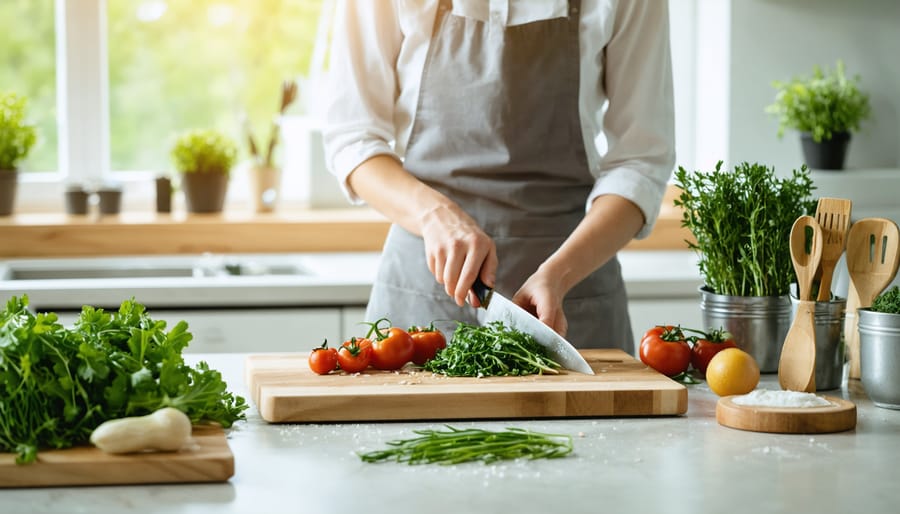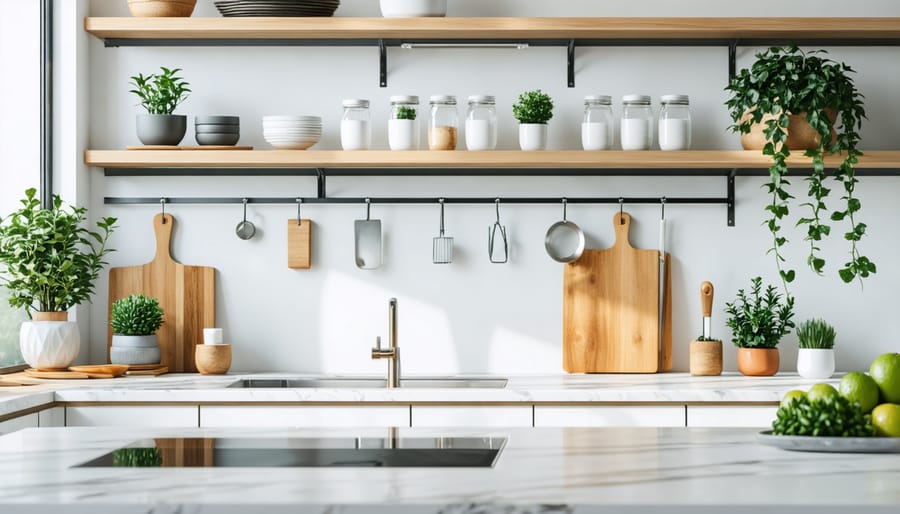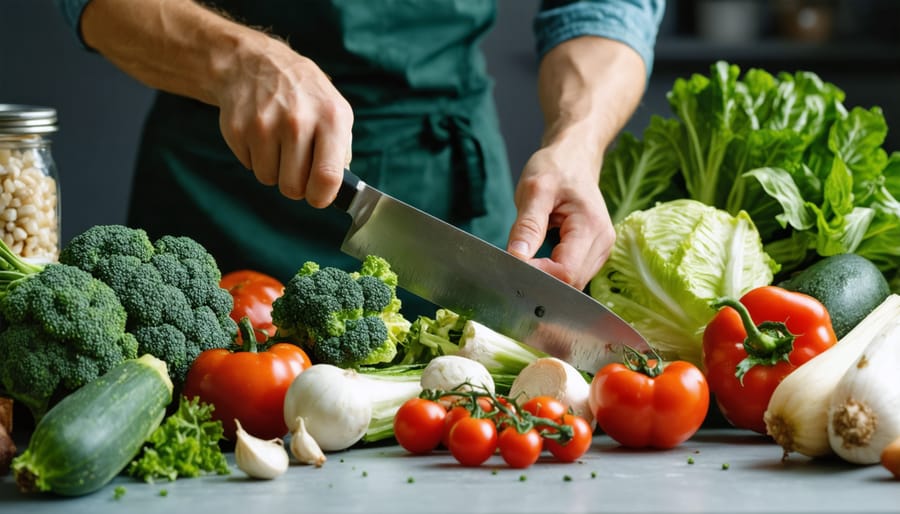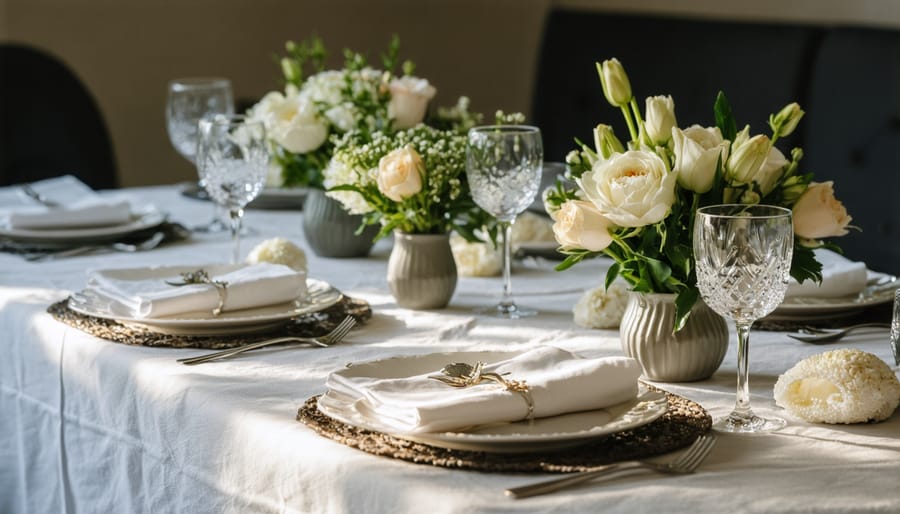
Transform your kitchen into a sanctuary of mindfulness by decluttering countertops until only essential tools remain visible. Create dedicated zones for different activities – a peaceful prep station, a thoughtful cooking area, and a mindful dining space. Position your most-used items at eye level, ensuring every movement flows naturally and purposefully.
Your kitchen holds untapped potential for practicing presence and intention. Whether chopping vegetables or washing dishes, these simple mindful cooking habits can turn routine tasks into moments of meditation. By treating your kitchen as a sacred space for nourishment rather than just meal preparation, you’ll discover a deeper connection to your food and the art of cooking.
The mindful kitchen movement isn’t about perfection – it’s about creating an environment that supports both physical and emotional well-being. When you step into a thoughtfully organized kitchen, your mind naturally settles, allowing you to approach cooking and eating with greater awareness and joy.
Creating Your Mindful Kitchen Space
Declutter and Organize with Purpose
When I first started my mindful kitchen journey, I discovered that mental clarity often begins with physical space. Learning to organize your kitchen efficiently can transform your cooking experience from chaotic to calm.
Start by clearing your countertops of items you don’t use daily. That coffee maker you reach for every morning? Keep it. The bread maker that hasn’t seen daylight in months? Find it a new home in the cabinet. When your workspace is clear, your mind follows suit.
Create intentional zones in your kitchen based on your cooking habits. Keep frequently used spices and oils within arm’s reach of your stove. Designate a prep station near your sink for washing and chopping vegetables. Group similar items together in your pantry – baking supplies in one section, breakfast items in another.
Consider the flow of your movement when cooking. Are your pot holders easily accessible? Can you reach your cooking utensils without stepping away from the stove? Small adjustments in placement can make a big difference in your cooking experience.
Remember, decluttering isn’t about achieving perfect minimalism – it’s about creating a space that works for you. Start small by tackling one drawer or cabinet at a time. As you organize, ask yourself: Does this item bring value to my cooking practice? Does it deserve the space it occupies? Let your answers guide your decisions.

Setting Up Mindful Cooking Zones
Just like a well-choreographed dance, an organized kitchen makes mindful cooking flow naturally. I learned this lesson the hard way after countless moments of frantically searching for ingredients while my garlic was on the verge of burning! Now, I swear by creating distinct zones that transform cooking from chaos to calm.
Start by establishing a prep zone with ample counter space, your favorite cutting board, and frequently used tools within arm’s reach. This becomes your mindful meditation spot where you can focus on the rhythmic chopping of vegetables and the textures of ingredients beneath your fingers.
Create a cooking zone around your stove, arranging essential spices, oils, and cooking utensils nearby. When everything has its place, you can stay present in the cooking process instead of scrambling for that missing wooden spoon.
Designate a plating area where you can thoughtfully arrange your dishes. I love having a clean, clutter-free space that lets me focus on presentation – it’s amazing how much more enjoyable meals become when you take time to plate them beautifully.
Don’t forget about a cleanup zone near your sink. Having cleaning supplies and tools readily available makes it easier to practice the mindful art of cleaning as you go, keeping your space serene and organized throughout the cooking process.
Remember, these zones should flow naturally with your kitchen’s layout and your personal cooking style. The goal isn’t perfection – it’s creating a space that supports your mindful cooking journey.
Mindful Cooking Practices
The Art of Slow Cooking
Remember those Sunday afternoons at my grandmother’s house, where the rich aroma of slowly simmering sauce would fill every corner? There’s something magical about slow cooking that goes beyond just preparing food – it’s about creating moments and memories.
In our fast-paced world, slow cooking offers a beautiful opportunity to practice mindfulness in the kitchen. When we choose to braise, simmer, or slow-roast our meals, we’re not just cooking; we’re participating in an age-old tradition of patience and presence.
Start by selecting recipes that require time and attention, like homemade soups, stews, or slow-roasted vegetables. These dishes not only taste better when cooked slowly but also fill your home with comforting aromas that create a sense of anticipation and warmth.
The beauty of slow cooking lies in its forgiving nature. You can chop vegetables mindfully, focusing on the texture and color of each ingredient. Listen to the gentle bubbling of your pot, observe how ingredients transform over time, and appreciate the gradual development of flavors.
Consider investing in tools that support this approach – a Dutch oven, a slow cooker, or a good quality heavy-bottomed pot. These become trusted companions in your mindful cooking journey. Remember, slow cooking isn’t about complexity; it’s about giving yourself permission to slow down and savor the process as much as the result.

Engaging Your Senses
The magic of mindful cooking begins when you fully immerse yourself in the sensory experience of preparing food. Let me share a little secret: when I first started practicing mindful cooking, it transformed my kitchen from a place of rushed meal prep into a sanctuary of culinary meditation.
Start with sight – notice the vibrant colors of fresh produce, the gentle steam rising from a simmering pot, the golden-brown crust forming on baking bread. Take a moment to appreciate these visual details that often go unnoticed in our hurry to get meals on the table.
Listen to the symphony of cooking sounds around you: the rhythmic chopping of vegetables, the sizzle of onions hitting a hot pan, the gentle bubble of a rolling boil. These kitchen melodies can become your anchor to the present moment.
Touch connects you deeply to your ingredients – feel the bumpy skin of an orange, the silky smoothness of butter softening at room temperature, the springy resistance of well-kneaded dough. Each texture tells its own story.
Breathe in the aromas wafting through your kitchen. The sharp scent of fresh herbs, the warm notes of baking spices, the comforting smell of homemade soup – these scents can trigger memories and create new ones.
Finally, taste mindfully. Rather than rushing through the sampling process, pause to notice the layers of flavor in your dishes. How do different ingredients complement each other? What subtle notes can you detect?
By engaging all five senses, you transform routine cooking into a rich, meditative experience that nourishes both body and soul.
Mindful Ingredient Selection
Last week, as I stood in the farmers’ market, carefully selecting fresh herbs for my weekly meal prep, I realized how this simple act of choosing ingredients mindfully had transformed my entire cooking experience. Mindful ingredient selection isn’t just about buying organic or premium products; it’s about creating a meaningful connection with the food we prepare and consume.
Start by taking a moment to consider each ingredient’s journey to your kitchen. Where was it grown? How will it contribute to your meal? This awareness helps you make more conscious choices and appreciate the value of each component. When possible, choose seasonal, local ingredients – they’re not only fresher but also help support your community’s farmers and producers.
Before shopping, take inventory of what you already have. This prevents waste and helps you plan more effectively. When selecting produce, use all your senses: notice the vibrant colors, inhale the fresh aromas, and gently feel for ripeness. These small moments of connection can turn a routine shopping trip into a mindful experience.
Consider keeping a food journal to track which ingredients make you feel your best. This personal insight helps guide future choices and creates a more intuitive relationship with food. Remember, mindful selection doesn’t mean perfect selection – it’s about making conscious choices that align with your values and well-being, one ingredient at a time.
Creating Mindful Dining Rituals
Setting the Perfect Atmosphere
When I transformed my kitchen from a chaotic cooking space into a mindful sanctuary, I discovered that the environment plays a crucial role in our mindful eating practices. Start by decluttering your countertops, keeping only essential items in view. This simple act can dramatically reduce mental noise and create space for intentional cooking.
Natural light is your best friend in creating a peaceful atmosphere. If possible, position your prep area near a window, allowing sunshine to flood your workspace. When natural light isn’t available, opt for warm, dimmable lighting that creates a gentle ambiance rather than harsh overhead fluorescents.
Consider incorporating elements that engage your senses mindfully. A small potted herb garden adds both visual appeal and aromatic pleasure. The gentle bubbling of a small fountain or soft background music can help drown out distracting noises. Choose calming colors for your kitchen accessories – think soft blues, gentle greens, or warm neutrals.
Temperature and air quality matter too. Ensure proper ventilation and maintain a comfortable temperature. I love keeping my windows slightly open when weather permits, allowing fresh air to circulate and carrying the delightful cooking aromas through the space.
Remember, creating your mindful kitchen atmosphere is personal. What brings peace to one person might feel overwhelming to another. Start with small changes and adjust until you find your perfect balance.

Family Connection Through Mindful Meals
In our fast-paced world, family meals often become rushed affairs between activities and commitments. However, creating meaningful dining experiences can transform these moments into precious opportunities for connection and presence.
Last week, my teenage daughter and I started a new dinner ritual: we take three deep breaths together before eating and share one highlight from our day. This simple practice has already sparked deeper conversations and genuine laughter at our table. It’s amazing how a few mindful moments can shift the entire energy of a meal.
Try incorporating these gentle practices into your family dining routine: Turn off phones and place them in a designated basket, light a candle to signal the start of your meal, or take turns expressing gratitude for the food and each other. For families with young children, make it playful – use a special bell to signal mindful eating time or play the “silence game” for the first bite to really taste the food.
Remember, mindful family meals aren’t about perfection. Some days might be chaotic, and that’s okay. The goal is to create small pockets of awareness and connection. Even five minutes of focused family time can nurture bonds and create lasting memories around the table. Start with what feels manageable for your family’s unique dynamic and schedule.
Solo Dining with Intention
Eating alone doesn’t have to feel lonely or rushed – it can be a beautiful act of self-care when approached mindfully. I used to grab quick bites while standing at my kitchen counter, but transforming my solo meals into intentional experiences has become one of my favorite daily rituals.
Start by creating an inviting dining space, even if it’s just a small corner of your kitchen. Set a proper place setting, use your favorite dishes, and maybe add a fresh flower or candle. These small touches signal to your brain that this is a special moment worthy of presence and attention.
Before eating, take three deep breaths to transition from your busy day into a more peaceful state. Express gratitude for your meal, whether silently or aloud. Notice the colors, textures, and aromas of your food. As you eat, put your phone away and focus on each bite, savoring the flavors and checking in with your hunger and fullness cues.
Use this time for gentle reflection or simply enjoying the quiet. Some people like to journal, read something inspiring, or listen to soft music. The key is finding what helps you feel nourished not just physically, but emotionally.
Remember, solo dining isn’t a substitute for social meals – it’s its own unique experience that can help you develop a healthier relationship with food and yourself. By treating these moments with intention, you transform an everyday necessity into a form of self-care.
Creating a mindful kitchen is more than just a home improvement project – it’s an investment in your well-being and quality of life. As we’ve explored throughout this article, transforming your kitchen into a mindful space can profoundly impact how you cook, eat, and connect with both food and loved ones.
Remember, this journey is personal and unique to you. Start small by implementing one or two changes that resonate most – perhaps beginning with decluttering your countertops or establishing a morning ritual of mindful coffee preparation. As these practices become natural, gradually incorporate more elements that speak to your vision of a mindful kitchen.
The benefits are truly transformative: reduced stress while cooking, more enjoyment from meals, stronger connections with family and friends, less food waste, and a deeper appreciation for the nourishment we prepare and consume. Many readers have shared how their mindful kitchen has become their favorite space for self-care and creativity.
I’ve witnessed firsthand how these changes can ripple through other areas of life, creating more peace and intention in our daily routines. Whether you’re an experienced home chef or someone who’s just beginning to explore cooking, your kitchen can become a sanctuary of mindfulness and joy.
Take that first step today. Your future self will thank you for creating this nurturing space where memories are made, meals are savored, and everyday moments become meaningful experiences.



